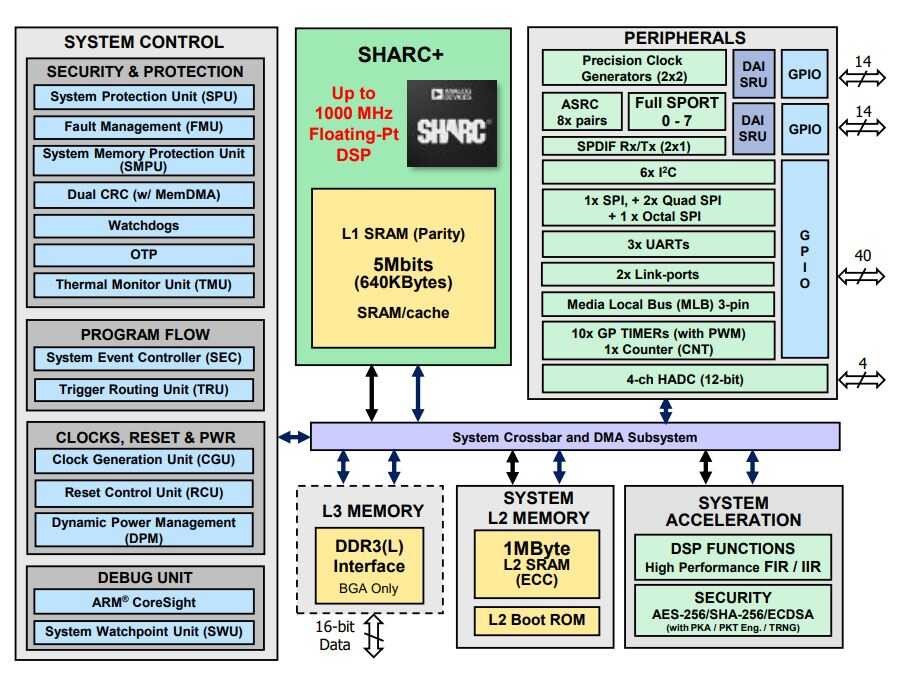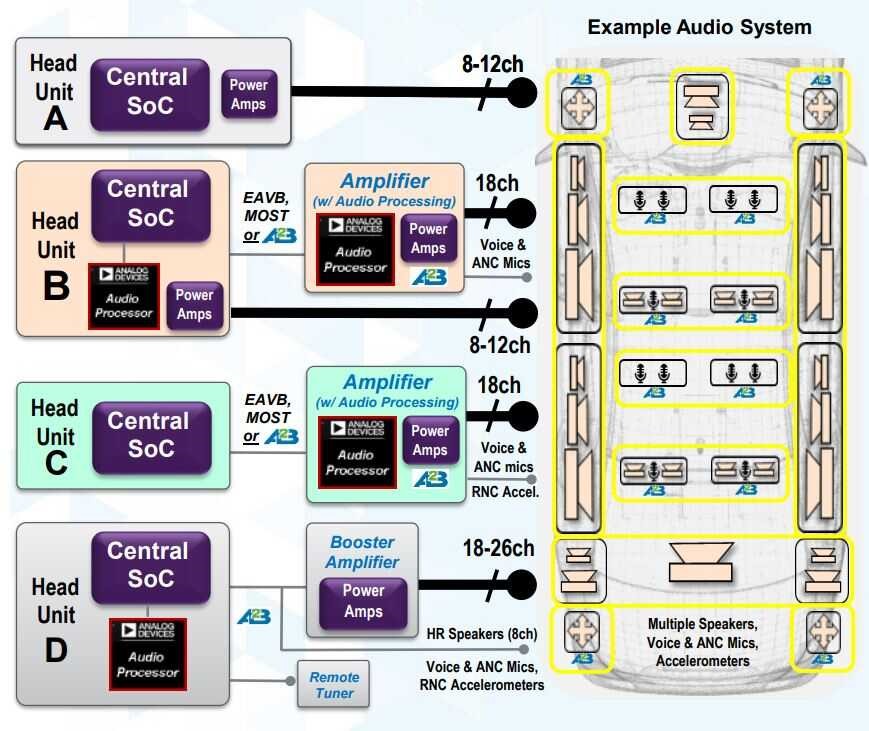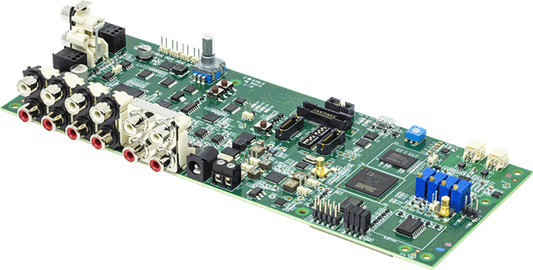By Maurizio Di Paolo Emilio, editor, Power Electronics News
Advanced electronics and smart sensors are leading to vehicles that are safer, smarter and consume less fuel than those of previous generations. Many of those same technologies that are making cars safer and more efficient are also being used to improve audio systems.
The audio systems in the latest generation of automotive vehicles must not only produce high-quality sound, but also provide advanced features that integrate with the car's multimedia network, all while keeping power consumption to minimum. Microcontrollers, memories, DSP (digital signal processing) are finding more and more application in this sector.
The new solutions will have to adapt quickly and easily to new trends, offering faster time to market and lower overall cost. Consumers will see the benefits in a new level of experience with a high degree of customization.
Bus technology for automotive audio
Car OEMs are seeking to reduce both system complexity and weight. Significant reductions in weight help reduce fuel consumption.
Analog Devices Inc. (ADI) is helping to solve this challenge with its Automotive Audio Bus (A2 B). The company says its digital audio bus technology offers high-fidelity audio for automobiles while significantly reducing the weight of existing wiring. The bus connects several remote sensors for different applications in a daisy chain sequence. A2 B technology can also supply power to other devices, reducing and possibly even eliminating the need for local power supplies, further reducing total system costs.
ADI also guarantees a reduction in the size of the connectors, replacing the current wiring based on a multitude of cables with a common unshielded twisted pair (UTP) cable. The bus includes a single master and up to 10 slave nodes, a very simplified discovery process, and a deterministic latency of just two clock cycles, independent of the node's position within the network.
SHARC: Real-time audio processing
Applications based on real-time signal processing require high computational capacity with low latency, indicating the use of digital signal processing. That has led to the introduction of DSPs with a multi-core architecture that integrate microprocessors. The DSP is dedicated to the data processing, leaving the microprocessor to control the bus and connectivity. The computing power is further amplified through the use of hardware accelerators such as FFT (Fast Fourier Transform) and FIR (Finite Impulse Response) and IIR (Infinite Impulse Response) digital filters.
The hardware structure must adequately maintain the data flow in and out of the processor, guaranteeing quick and easy access to the memory with an adaptation of the data protection system. The system includes security that guards against illegal reprogramming and also protects data. The processor has diagnostics and mechanisms for detecting and correcting errors.
ADI’s SHARC (Super Harvard Architecture) DSPs are particularly suitable for low latency real-time audio processing with robustness and reliability required for automotive applications.
The latest series of audio processors from ADI has dramatically improved sound quality. The ADSP-2156x audio processors (ADSP-21562/21563/21565/21566/21567/21569) are specifically designed for applications that require deterministic and low-latency real-time audio processing, including immersive 3D sounds and personal audio zones, and active cancellation of automotive noise and road noise (ANC/RNC).
The single-core 32-bit/40-bit/64-bit floating-point processors with SHARC + architecture, reach speeds up to 1 GHz and combine flexible audio connectivity with different chip memory options. New additions include cache improvements and branch prediction while maintaining instruction set compatibility with previous SHARC products (Fig. 1 ).

Fig. 1: ADSP-2156x processor block diagram.
The ADSP-2156x family features a large on-chip SRAM up to 1.6 MB, which increases audio processing performance and eliminates the need for external memory. The on-chip hardware FIR and IIR filter accelerators offer significant additional processing capacity while reducing overall system costs. The efficient DMA with innovative digital audio interfaces and internal buses eliminates bottlenecks for processing. DDR3/L connectivity (in BGA only) offers easy application expansion with reduced system design effort.
The devices are available in CSP BGA (17 x 17 mm, 0.8-mm pitch, 400 pin) and 120-lead LQFP (14 x 14 mm) packages in both automotive and consumer grades.
“Our SHARC audio processors are equipped with robust security features to prevent unauthorized access of our customers’ IP. This enables our customers to innovate and differentiate with their solution. As vehicles are becoming smarter and more connected, security has come to the forefront of architecting our next-generation of products” said Andrew Lanfear, ADI’s product line director, Audio Processing & Connectivity.
“With the new ADSP-2156x SHARC audio processor family, we are continuing to enable our customers with the performance scalability to build system cost optimized solutions for highly deterministic and low latency real-time audio processing applications in automotive, consumer and professional audio,” said Jignesh Sonchhatra, said ADI’s product line manager, Automotive Audio Processing. “Some of the automotive applications include active and road noise cancellation (ANC/RNC), in-cabin voice UI, in-car communication, personal audio zones, engine sound synthesis, electric vehicle warning sound system. The end goal is to provide immersive 3D audio and quiet in-cabin experience to vehicle occupants as well as increased driver and pedestrian safety.”
ADI has designed an ADZS-21569-EZKIT development board with all the necessary hardware to evaluate the ADSP-2156x family. The evaluation board is designed to be used together with CrossCore Embedded Studio (CCES) development tools, helping the development and debugging of advanced application codes (Fig. 2 and Fig. 3 ). It is equipped with 12 RCA connectors, an ADAU1979 quad ADC, an ADAU1962A 12-channel, 24-bit DAC, an ADAU1977 quad microphone ADC with diagnostics, and an AD2428 Automotive Audio Bus (A2 B) transceiver.

Fig. 2: Example of an audio system.

Fig. 3: ADZS-21569-EZKIT development kit for the ADSP-2156x.
The requirements of low latency real-time audio processing are stringent. The need for processors with a high degree of digital processing is essential to meet the ever-stringent requirements of the automotive industry. The autonomous car of the future will not only be sensors and cameras, but will also be used as a home theater, conference room, and entertainment center on the move, each of which depends on exceptional sound. This means automotive companies will need to integrate sophisticated digital audio algorithms to offer high-quality and real-time processing.
The article originally published on sister publication EE Times.
Advertisement
Learn more about Electronic Products Magazine





